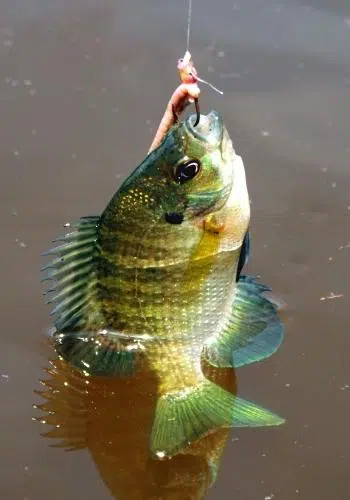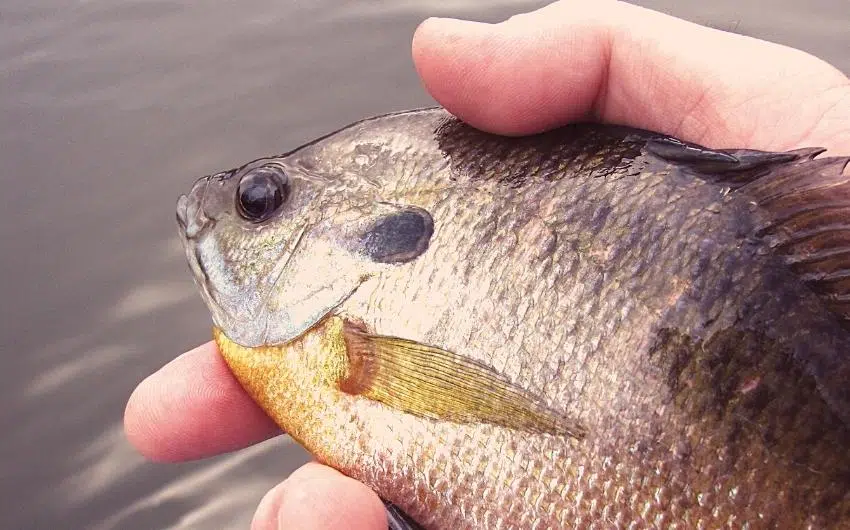How big do Bluegills have to be to keep? Bluegills are a popular game fish, and for a good reason – they’re plentiful and put up a good fight. But how big do bluegills have to be before you can legally keep them? This post will break it down for you, so you’ll know what size bluegill to target when fishing!
Quick Jump
ToggleCan You Catch and Keep Bluegill?
The Bluegill is a very liberal fish, with bag limits typically allowing for 25 per day. It’s your duty as an angler to catch and eat them all – keep the herd in check!
Sounds good, but current research suggests this may not be how things work out.
Bluegills are declining in many states, and some fisheries have even prohibited bluegill fishing from protecting the species.
Since bluegills can live for more than a decade and reach 18 inches in length, there’s no doubt that catching and eating so many of them is not sustainable. So what’s the alternative?

Well, it might be time to start targeting some larger bluegill. Just how big do Bluegill have to be before you can keep them?
What Size Can You Keep a Bluegill?
How big does Bluegill have to be to keep? In general, The Bluegill in the 6 to the 8-inch range can be an excellent treat for fishers. The meaty flavor and small size make them worth catching, first of all, because they’re not trophy-sized, which means other anglers have an opportunity at your catch too.
It’s also a great idea to keep bluegills in your life well and then release them into your local pond.
The Bluegill is a popular fish with many predators, and this can be a great way to help protect local fisheries.
It’s also important not to forget that the Bluegill is also a native species. Many fisheries are stocked with bluegills, but these fish can often breed with wild-caught specimens, resulting in reduced genetic diversity for the wild bluegill population.

What Size Bluegill Is a Keeper in Florida? (Bluegill Size Limit Florida)
In Florida, anglers may keep no more than five bluegills and Sunfish 8 inches or longer in total length per day.
The fishing regulations for this state are stringent when it comes to fish size limits–in order not to exceed them, you will need a license from your local sportsman’s organization!
How Big Do Bluegills Have to Be to Keep in Wisconsin?
In Wisconsin, you can keep five Bluegill per day. The fish must measure at least nine inches from the tip of the lower jaw to the fork of the tail.
Wisconsin customers have access to a popular fishing report for bluegills near you. Most people do not realize, but there are significant differences in the size of these fish in different parts of Wisconsin.
What Size Bluegill Is a Keeper in Ohio?
Bluegills are the most popular fish found in Ohio waters. They often grow to be around 6 inches long, but bluegill reaches up to 12″! In Ohio, you can keep five bluegills per day at least 6 inches fish length.
What Size Does Bluegill Have to Be to Keep in Michigan?
Michigan’s daily limit for male bluegills is 25 large males, either singly or with other sunfish species combined.
Michigan requires that fish be at least 5 inches long to keep, but there is no minimum size for bluegills in this state.
How Small of a Bluegill Can You Eat?
The Bluegill is a top choice among the sunfish family for cooking and taste quality. With an average length of 9 inches, the Bluegill is considered one of our favorite Sunfish for cooking and tasting quality fish.
The Bluegill is a popular fish in America. The most common type of Sunfish can be found on many menus and has an excellent flavor quality that makes it one of the best options available to consumers looking for something fresh from their local waters!
The meat has been reported to be mild, firm yet still juicy, with excellent flavor when raw or cooked upon request!
How does bluegill taste? Answer: Bluegills have mild, white meat that is great for smoking. They can be cooked in just about any way, but they are best when fried.
It doesn’t have that “fishy” taste many other types do, which makes it perfect as both an entertaining dinner party dish and a simple camp meal.
You can make it without feeling too guilty about eating healthy while enjoying nature’s beauty all day long.
How Big Does a Bluegill Get?
Bluegills are a common type of fish found in North Carolina. The average length for this species is 19 inches, but some have been recorded at 41 centimeters–more than two feet long!
In general, bluegills have a range of colors from pale olive to reddish-orange on the back and sides. The scales on this fish are small and delicate.
What Is Considered a Big Bluegill?
Well, the typical size of Bluegill is six or seven inches. However, some can be ten inches long and three pounds in weight.
While the typical Bluegill is six or seven inches long, some can be up to ten inches and weigh three pounds.
These are considered large sexually mature specimens, which are not very common to find in the wild unless they were stocked as fingerlings and were never caught.
What Is the Best Time to Catch Bluegill?
The best time to catch bluegills is usually during a 2.5-hour window from 4:30 pm until sunset, but there are some exceptions because weather and body of water conditions can change this schedule dramatically!
Bluegill is active during both day and night. You are most likely to find them in the early morning hours near the shoreline at a depth of about 30 feet and again in the evening when they move back into shallow water at a depth of no more than five feet.
What Is the Biggest Bluegill Ever Caught?
The IGFA has recorded the world’s largest Bluegill, which was caught at Ketona Lake in 1950. This bigger fish weighed 4 pounds 12 ounces and measured 9 inches long from head to tail!
How Do I Find Bluegill from the Bank?
Bluegill is usually found in schools but will become solitary when the spawning season begins. They will typically school at depths of five to ten feet but can be found in deeper waters as well.
Catching Bluegill from the bank is easy if you use live baits or lures alongside prominent covers like docks, logs, and Lily pads. Approach calmly so as not to alert fish near your presence in this Area of Interest.
Can You Have Too Many Bluegill in Pond?
Bluegills are great for ponds and lakes because they are highly tolerant of most water conditions. They will eat anything, so they are a good choice if you are trying to stock for food.
Stocking a pond with fish can be an excellent way to ensure constant customers for 20 years.
A typical stocking strategy would include 1,000 -1 500 bluegills and 50 – 100 largemouth bass per acre. Bluegills are great for ponds and lakes because they are highly tolerant of most water conditions.
How Do I Catch a Bluegill in My Pond?
You’ve decided to try your hand at fishing, and you’ve chosen Bluegill as your prey. Now what?
Fishing can be a fun and rewarding hobby, but starting on the right foot is essential. If you’re new to fishing, catching Bluegill can seem like an impossible task.
How Do I Catch a Bluegill in My Pond is the perfect guide for beginner anglers. This step-by-step video will teach you everything you need to know about how to catch Bluegill, from choosing the right bait to landing your fish.
Is It Safe to Eat Bluegill from Pond?
Bluegills are not only great tasting but also very good for you! One of the many benefits of Bluegill is that it is low in fat, calories, and cholesterol.
Ponds are an excellent food source for anglers, but they can also carry some risks. Fish may be carrying parasites that could make you sick if not cooked properly or eaten at all!
As with any fish you catch, make sure you clean it properly before cooking. And remember to follow safe handling instructions when you are in an Area of Interest.
What Is the Difference Between Bluegill and Sunfish?
Bluegills and Sunfish are very similar in shape, but the main difference is that Bluegill has a black spot on their big gill cover and Sunfish do not.
Bluegills can be distinguished from other types of Sunfish by their molar-like teeth, whereas other Sunfish have pharyngeal teeth.
The two most popular types of fish you can find at your local grocery store are Bluegill, located in freshwater lakes and streams; Sunfish live near saltwater shores or even oceans.
For starters, there isn’t just one type called bream! Bluegills tend to be smaller than their counterparts- typically ranging from six inches long to three pounds (1kg).
They also have shorter anal fins and white stripes along each side edge starting behind where they would typically possess decent-sized eyes.
How Big Sunfish Have to Be to Keep It?
The Department of Health has guidelines for how many Sunfish you can eat per week.
They say it’s safe to consume regularly, but if your fish grows over 7 inches, then they advise releasing them back into the water so that other smaller fish species won’t get it at first!
What Is the Limit for Sunfish in Minnesota?
The regulations for Sunfish in Minnesota are that you can keep up to 6 fish per day, but the pound limit is only one Sunfish per day.
There are many types of Sunfish, but the average length is around 8 inches, give or take, 2 pounds. If you go to Minnesota, you can keep up to 6 sunfish per day.
Minnesota has a limit of 1 pound for Sunfish, which is great because it means you can keep one for your dinner and then let the rest go back into the water.
Conclusion
The Bluegill is a small freshwater fish that can be caught in most ponds and lakes. You’ll want to look at or observe closely out for the size structure of your catch if you are wondering whether or not it will make good eating.
Typical bluegill weighs less than one pound (0.45 kg) but grows more extensive, with some individuals reaching over 3 pounds (1.4 kg). If you find yourself fishing for these little guys during warmer months, try using Worms and Nightcrawlers as baits because this is their favorite food! Bluegills also like crickets, so don’t forget to put those on your hook too!
As winter approaches, these fish migrate back into deeper waters, so if you want to know more about how big do Bluegill have to be to keep! Keep reading this entire blog post.
You might also love:


